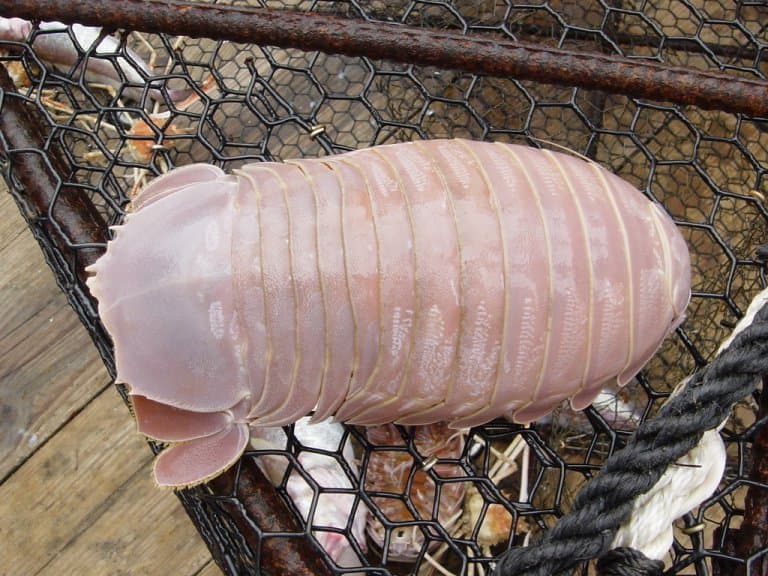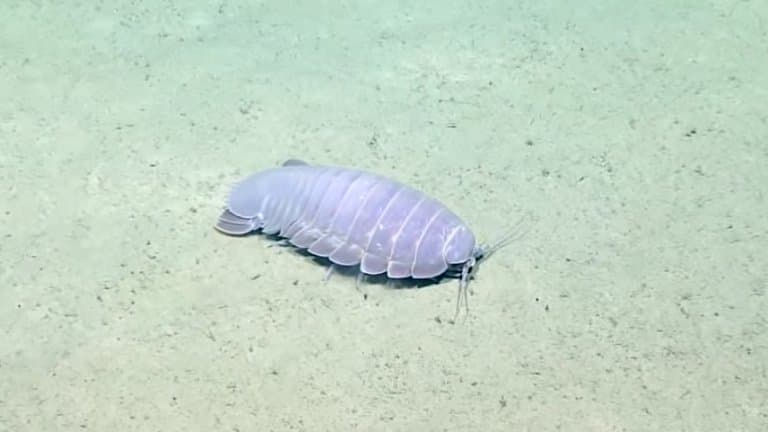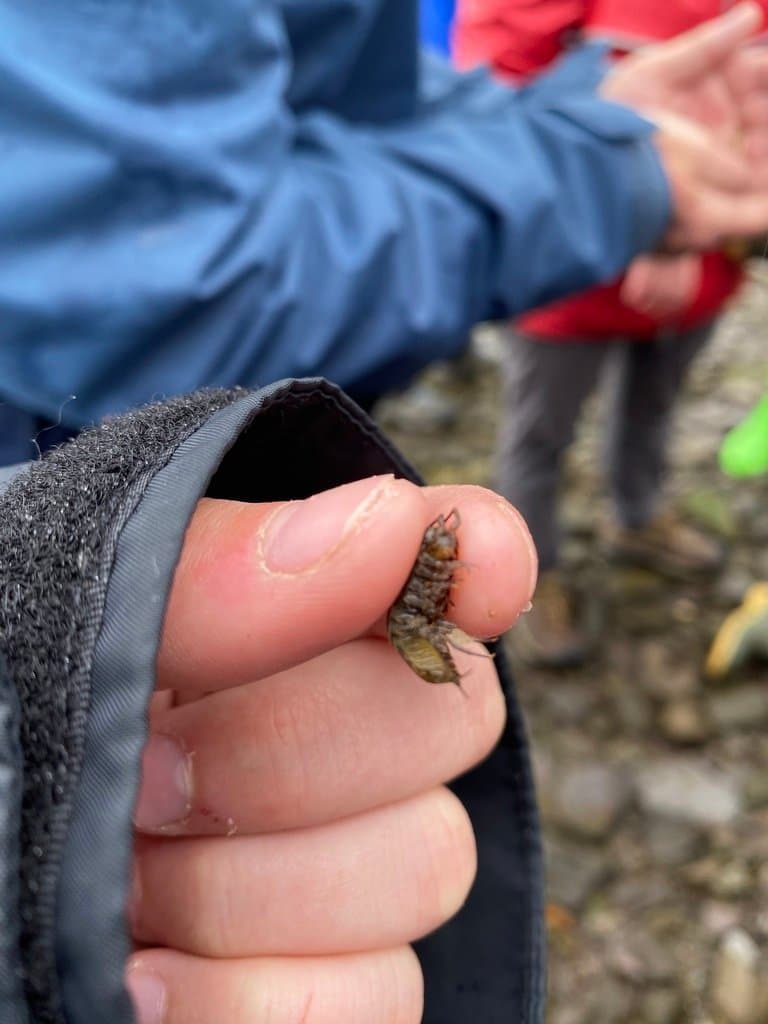Giant Isopod Profile
The giant isopod, first identified in 1879, comprises any of around 20 species of this group of large crustaceans, closely related to shrimp and crabs.
The inhabit in abundance the frigid deep waters of the Atlantic, Pacific and Indian oceans, and can be found at depths of up to 7,000 feet.
The giant isopod is in fact one of the largest crustaceans in the sea. ‘Bathynomus giganteus’ is the largest of them all, and can reach lengths of up to 50 centimetres, with a weight of over 3.5kg.
The bizarre and somewhat fearsome looking creature vaguely resembles a large woodlouse or small armadillo. They have a very hard exterior shell (exoskeleton) coloured pale pink, lilac or beige, which is made up of curved segments.

Giant Isopod Facts Overview
| Habitat: | Deep sea: 500-7,000 ft, mud or clay seabed |
| Location: | Most regions of the World Ocean |
| Lifespan: | Not well known, thought to be in the decades |
| Size: | The largest up to 50cm in length |
| Weight: | Up to 3.7lbs |
| Color: | Brown or cream, sometimes very pale lilac or pink |
| Diet: | Marine debris: crab flesh, marine worms, fish |
| Predators: | No natural predators |
| No. of Species: | Around 20 known species |
| Conservation Status: | Not endangered |
The giant isopod’s body is made up of three distinct segments: the head (cephalon), thorax (pereon) and abdomen (pleon); these fused segments mean that the body is both strong and flexible. The abdominal section is made up of five curved pieces, each with a branch or flap at either end which are used for movement and also respiration.
Like all crustaceans, the giant isopod has jointed legs: fourteen of them in seven pairs. The first two legs are used for holding or moving food to the mouth, the others are for swimming.
Giant isopods feed mostly on drifting parts of dead and decomposing sea creatures closer to the ocean surface – fish, crab, shrimp, squid, or even whale falls.
While they are generally considered to be scavengers, there is some evidence of them preying on live creatures too, such as the slow-moving sea cucumber or sponges. When they encounter a large food source, giant isopods are known to gorge themselves to the point where they struggle to propel themselves through the water.
Reproduction happens during spring and winter, probably because food is more available at this time. The giant isopod reproduces through laying eggs. Clutches of 20 to 30 eggs are stored in a pouch above the female’s internal organs until they hatch.
Females tend not to feed during the brooding time, instead they sink into the mud and silt of the seabed to insulate and protect the eggs.
Interesting Giant Isopod Facts
1. Giant isopods are ancient creatures
Incredibly, fossil records suggest that the giant isopod existed over 160 million years ago, meaning that these strange beings have inhabited the Earth’s oceans for longer than we can possibly imagine.
They are even older than dinosaurs such as the tyrannosaurus rex!
Comparisons of giant isopod specimens from different locations across the globe have indicated that evolution has been minimal in these creatures, perhaps because of the very low light levels in their habitat. 1

2. Despite being sea creatures, giant isopods are relatives of the woodlouse
Although their connection is quite distant, the huge 14-legged deep-sea dwelling giant isopod is a relative of the common back-garden dweller. There is a big difference in size – the common pill-bug averaging a length of 2.5 cm, in comparison to its giant cousin at lengths of up to 40cm (16 inches).
Just like the woodlouse, the giant isopod has the ability to curl up into a ball when it feels threatened, meaning that their soft underside is protected by their tough exoskeleton shell. 2
3. They have a cool fan-like tail for swimming
To swim it uses a fan-like tail and small, fluttery swimming limbs, which help movement through the water but also aid in respiration.
There are hooked claws on the end of its legs to give more stability on the rough ocean floor. Giant isopods have two pairs of antennae: one short, and one very long – these being sensory organs – as well as having very large eyes in comparison to their body.
These adaptations help them navigate with the lack of light at the ocean floor.
4. The giant isopod has an incredibly slow metabolism
Isopods are scavengers, and rely on food falling from higher in the water column; for example, parts of decaying marine animals closer to the surface of the ocean that drift down towards the sea bed. This decaying material is known as ‘marine snow’ and is what isopods feed on.
Due to the lack of light, it is rare to find any other type of food on the ocean floor. The nature of marine snow means that it can be hard to come by, and isopods have adapted to patiently wait for the nourishment they need to survive, meaning they have an extremely slow metabolism and are always in a state of semi-hibernation.
An isopod kept in captivity in Japan was observed to last for five years without feeding. They conserve their vital energy only for necessary movement and respiration. 3
5. Giant isopods have no known natural predators
This is partly due to their remote, deep-sea location – not many predators roam this deep.
In addition, their natural armour is off-putting to potential predators: they have an incredibly thick, strong outer shell – like a crab – but less meat on their bodies than crabs, meaning they are not really worth the effort of breaking through the outer protective layer! 4
6. There are a number of theories regarding why the Bathynomous giganteus has grown to such a size
Reaching lengths of up to 40 centimeters, the largest of the giant isopods is significantly larger than some of its relatives.
One reason for this is due to its natural habitat – creatures that live so far beneath the ocean surface need to carry more oxygen in their bodies to survive, meaning that they may have larger bodies and longer legs; and their bodies must additionally be able to withstand enormous pressure.
Similarly, the deeper an animal lives the fewer predators it has, therefore they can safely reach larger sizes without fear of detection.
Two other scientific rules that can explain deep-sea gigantism are Kleiber’s rule, which states that larger animals are more efficient; and Bergmann’s rule, which states that sea creatures dwelling in very cold water tend to be larger in size.
7. The giant isopod has no spine
Just like all crustaceans, giant isopods rely on their extremely tough exoskeleton to protect and support their bodies.
Their lack of spine makes them an invertebrate, which is why they made our Largest Invertebrates in The Ocean list.
8. Giant isopods are one of an estimated 10,000 species of isopod!
Isopods can range in size from a few milimetres to many inches in size and can be land or sea dwelling.
Most can just be picked up and held in your fingers!5

9. Giant isopods have a reflective layer at the back of their eyes
Light bounces off this reflective area and causes the eyes to appear to glow, adding to the slightly ghostly look of these giant crustaceans.
10. Giant isopod eggs are the largest of marine invertebrates
The eggs can be up to half an inch in length, which is very large in terms of most marine invertebrates.
When the eggs hatch, the ‘manca’ (hatchlings) are tiny replicas of the adult giant isopods. The manca are up to 6cm long when they hatch.
11. Giant isopods are consumed by humans in some places
Although the giant isopod is not commonly fished commercially, it can be found on menus in some Asian restaurants.
It would generally be served boiled with rice.
12. Despite their unappealing looks, giant isopods are not dangerous to humans
While their habitat and location means that it would be very unlikely for a human to encounter one of these scary-looking creatures, the giant isopod is not venomous or poisonous and relies only on its tough shell for protection against predators.
13. Although giant isopods live far away from human life, our actions still impact them
Despite their remote home hundreds of meters below the ocean surface, giant isopods are nevertheless still affected by humans and their love of plastic.
Studies have shown that microplastics, which are the tiny, almost invisible pieces of non-degradable plastic, have been found all the way from the ocean surface to its very depths.
These microplastics make their way into the food chain either through direct ingestion, or from the consumption of marine life that have ingested microplastics (since plastic cannot be digested, it will remain inside whatever creature eats it until that creature, too, is eaten).
Brooding females are also often found tangled in the nets of deep sea trawlers.
Giant Isopod Fact-File Summary
Scientific Classification
| Kingdom: | Animalia |
| Phylum: | Arthropoda |
| Class: | Malacostraca |
| Order: | Isopoda |
| Family: | Cirolanidae |
| Genus: | Bathynomus |
Fact Sources & References
- Emily Osterloff “Giant isopods: curious crustaceans on the ocean floor”, National History Museum.
- Margaret Osborne (2022), “New Species of Deep Sea Isopod Discovered”, Smithsonian Magazine.
- “Giant isopod Bathynomus giganteus”, Monterray Bay Aquarium.
- “Giant Isopod Facts – Animals Of The Oceans”, World Atlas.
- Corryn Wetzel (2022), “Giant yellow crustacean in an aquarium turns out to be new species”, NewScientist.
